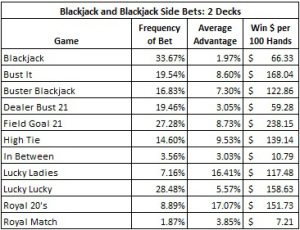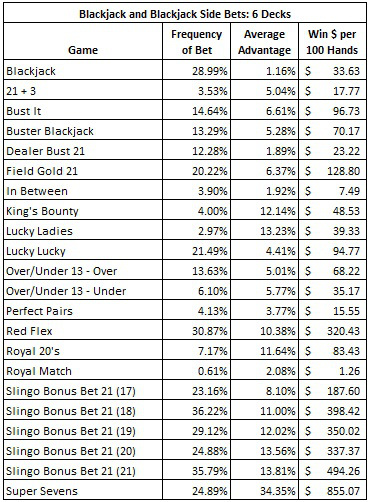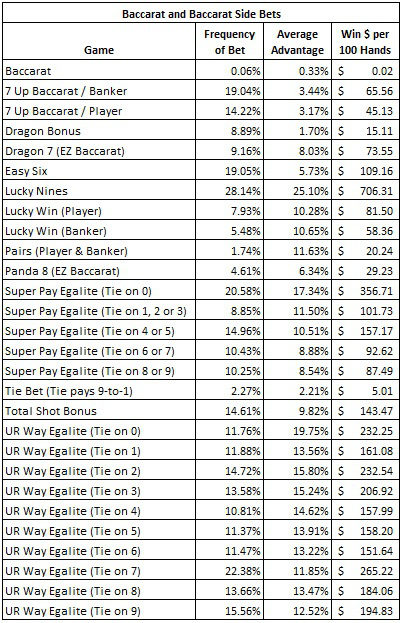Every once in a while I like to take a step back and see where I am. Such is the case with card counting blackjack, baccarat and their respective side bets. In this article I am going to give summary statistics for every game and side bet I have analyzed for card counting in this blog. I hope this will give some perspective on the overall landscape of vulnerabilities. I am still finding that some in casino management obsess over small things while ignoring gaping and obvious holes in their game protection. For the most part, card counting is a very small thing. Unfortunately, some in casino management still sweat the small things. Sweat equity is often worthless.
Three baseline statistics have evolved as I've written these posts. These statistics allow cross-comparison between various opportunities in a way that makes their relative vulnerabilities transparent. These statistics are:
- Frequency of Wager (bet frequency). This number indicates the percentage of hands overall in which the true count exceeds the trigger count, in other words, the percent of hands the card counter will make the wager.
- Average Advantage (EV per Bet). When the AP makes a wager, his edge will vary. Unlike hole-card play, edge sorting or collusion, card counting does not afford a static edge. This number gives the average edge the AP has over the casino when he makes the wager.
- Win per 100 hands. Assume an AP is card counting the given game. He makes a $100 wager on the game whenever he has the edge (as indicated by the true count), otherwise he makes no bet. Then, this number is the average amount the AP will earn per 100 hands.
This last statistic, "win per 100 hands," is my default measure of risk comparison. It is true that some games move faster or slower. A full six-deck table will move slower than a heads-up double-deck game. Baccarat almost always moves slower than blackjack. Mini-baccarat moves faster than squeeze baccarat. There is no reasonable way to normalize win-potential by game pace. Normalizing by a fixed number of hands at a fixed wager allows games of the same type to be easily compared.
It is my hope, going forward, that "win per 100 hands" will be the metric used by gaming companies when they publish statistics about their own game's vulnerabilities to card counting or other methodologies. My hope is currently two steps removed from reality. First, no game company has yet published accurate advantage play numbers on any game. Second (with this exception), they don't even appear to be making an attempt.
It is worth noting that some of the card counting systems presented here are not human-feasible. That does not mean they are not being used. For example, beating the Pairs bet in baccarat works quite well using a smart phone with the right app installed. On the other hand, the method I propose for 21 + 3 is useless, at best.
Another note is that some wagers are actually combinations of wagers that may require separate card counting. This is the case with the Slingo Bonus Bet 21 in blackjack, and the UR Way Egalite side bet in Baccarat. A team may work together to keep several counts and share information, allowing the team to beat games far more efficiently than a lone counter.
First, I summarize my results for double-deck blackjack. In this game, I always assume that the cut card is placed 75 cards from the start of the shoe (29 cards from the end). This is deeper placement than is typical for most casinos, hence my results give an upper bound for most casinos.
It is extremely useful to first state the statistics for the perfect high-low blackjack card counter. By perfect, I mean that the counter knows every high-low index. He wagers $100 whenever he has the edge, otherwise he wagers $0. He plays perfectly index strategy. He plays 100 hands.
Almost everyone I have ever met in the casino industry overestimates the danger of this individual. Once we know the win potential of this AP, every other game can be compared to the ordinary blackjack card counter. Here is the damage a perfect two-deck blackjack card counter can do:
- Frequency of bet: 33.67%
- Average Advantage: 1.97%
- Win $ per 100 hands: $66.33
Are you sweating the small stuff?
The following table gives statistics for every two-deck blackjack wager I have analyzed in this blog:

Assuming a lone card counter, the top three most vulnerable wagers in a two-deck game are:
- Field Gold 21 ($238.15 per 100 hands)
- Bust It ($168.04 per 100 hands)
- Lucky Lucky ($158.63 per 100 hands)
Next, I present six-deck blackjack. In this game, I always assume that the cut card is placed 260 cards from the start of the shoe (52 cards = 1 deck from the end). This is deeper placement than is typical for most casinos.
Here are the baseline statistics for the perfect Hi-Lo blackjack card counter who is playing against the six-deck shoe game:
- Frequency of bet: 28.99%
- Average Advantage: 1.16%
- Win $ per 100 hands: $33.63
The following table gives statistics for every six-deck blackjack wager I have analyzed in this blog:

Assuming a lone card counter, the top three most vulnerable wagers in the six-deck shoe game are:
- Super Sevens ($855.07 per 100 hands)
- Slingo Bonus Bet 21 (21) ($494.26 per 100 hands)
- Red Flex ($320.42 per 100 hands)
Note, I only included one of the Slingo wagers in the list above.
Finally, I present baccarat. In this game, I always assume an eight-deck shoe. I assume that the cut card is placed 14 cards from the end, which is the traditional placement using the ribbon spread. I assume that if the cut card appears mid-round, then one additional round is dealt. I assume that if the cut card is the first card out of the shoe, then two additional rounds are dealt.
I also assume the standard baccarat burn card rule in my analysis. In this rule, the first card out of the shoe is removed and exposed. The value of this card gives the number of additional cards that are burned face down before the start of the first round. If this card is a T, J, Q, K, then 10 cards are burned.
The following table gives statistics for every baccarat wager I have analyzed in this blog:

Assuming a lone card counter, the top three most vulnerable wagers in eight-deck baccarat are:
- Super Pay Egalite (Tie on 0) ($356.71 per 100 hands)
- UR Way Egalite (Tie on 7) ($265.22 per 100 hands)
- Total Shot Bonus ($143.47 per 100 hands)
Note that I did not include Lucky Nines. My understanding is that this side bet has never been offered in a live casino in a fashion that would allow card counting.
Hopefully you are also a bit surprised to not see EZ Baccarat (Dragon + Panda) make the top three. In combination, using separate counts for each, the AP earns $102.78. A combined count yields less. With all the hubbub, it turns out to be a mediocre opportunity, at best.


